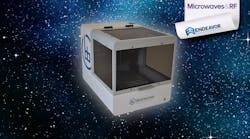This article appeared in Microwaves & RF and has been published here with permission.
What you’ll learn:
- Why the Space Force is looking to electronic design and manufacturing solutions.
- Why 3D-printed PCBs hold promise.
- The long-range possibilities of electronics manufacturing in space.
The U.S. Space Force (USSF) issued a grant to BotFactory and its partner Cornell University to develop the ability to manufacture electronic components and circuit boards in space on demand in micro-gravity environments.
The USSF is the newest branch of the Armed Forces, created to organize, train, and equip space forces to protect the U.S. and its allies. To help support their mission, they’re partnering with private companies to explore technology solutions for space.
This grant is critical to determine how electronics will be manufactured in space so that missions needn’t rely on resupply from earth whenever components fail, or new parts need to be developed.
Here on Earth, printed circuit boards (PCBs) are widely used in electronic devices, from simple circuits to the most complex smartphones. However, these delicate components are notoriously difficult to manufacture in space. The main challenge is that the traditional process for creating complex PCBs uses and pollutes tons of clean water, needs to deal with heavily pollutant substances, and requires highly controlled processes to avoid fires, explosions, and other dangerous situations due to the delicate materials utilized.
3D printing has emerged as a potential solution for fabricating PCBs in space. This technology offers greater flexibility and accuracy than traditional manufacturing methods. It has a smaller footprint, wastes less resources, and can be fully automated—thus, astronauts won’t need extensive training to use the technology.
No one has tried to make 3D-printed PCBs work in space. As a result, astronauts currently rely on PCBs manufactured on Earth and then transported back to their space station. Although this approach is expensive and time-consuming, it’s currently the only way to ensure that astronauts have access to reliable electronics.
BotFactory and Cornell University can now set about to validate the idea of always-available electronic manufacturing for in-situ environments like space. Reliable 3D-printing technology could prove to be an essential part of the success of any long-term mission, especially in the ability to create adaptive technology for the ever-changing needs of space travel and colonization.
Long-Term Impact of the Project
Like many technologies that started in space, from artificial limbs to solar cells, the technologies developed for an in-space PCB printer can be applied both in space and here on earth. Due to the constraints proposed by the environment, it’s likely that these new processes will be more efficient in terms of material usage, will generate less waste, and would be made so that they’re easier to use and maintain.
Native Environmental Materials
Another intriguing idea is to use materials native to the local environment to form electronics—for example, minerals on the Moon. What we call “Moondust” also is known as Moon regolith, and it's rich in multiple materials, including silicon, aluminum, and clays. These can be leveraged as principal materials for a PCB so that the supply chain can be self-reliant. Since 3D-printed circuit boards don’t rely solely on silicon, engineers can get creative about their materials.
High-Purity Chip Manufacturing
Producing PCBs and components, passive and active, poses many challenges in Earth’s environment. However, space may have some advantages to offer. For example, one of the biggest hurdles and expenses in electronics fabrication is operating the power-and-water-hungry clean rooms, since even a speck of dust can prove catastrophic.
Fortunately, such a sterile environment is ubiquitous in space. Therefore, in-space production applications (InSPA), like high-purity chip manufacturing, can provide a domestic strategic and economic advantage to companies that develop solutions.
In an era where the U.S. Congress is supporting the electronics industry with $52 billion through the COMPETES Act to bolster domestic electronics manufacturing and cut outside dependencies, new technologies developed by the USSF can be a huge advantage on Earth.
In addition to the goals for sustainability, private markets also are taking an interest in the potential of space. Areas like space tourism, mining on distant planets and asteroids, and manufacturing in space are potential future markets worth billions of dollars. And all of these areas will require permanent space installations that rely on sophisticated electronics to function.
Today, due to environmental constraints, human-crewed missions in space need to rely on Earth to supply critical new electronics or repair aging ones. Perfecting the 3D printing of electronics in micro-gravity would be a big leap forward in electronic design and manufacturing. The technology developed for an in-space PCB printer will spawn other technologies that can be applied in space and here on Earth.
